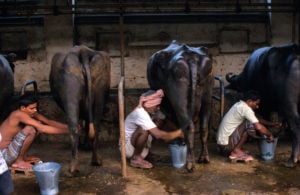For more than a year, India’s farmers came together in the largest protests in world history. Demonstrations started in earnest in September 2020, when three contentious laws were passed, and lasted until the laws were repealed in December 2021.
Nearly half of India’s population is dependent on agricultural income, or income linked to agriculture, which means that large-scale change to farming impacts over 600 million people. That said, the sector has been in distress for decades, with tens of thousands of farmers committing suicide. Changing rainfall patterns, an impact of climate change, have made agriculture even more risky, especially since half of Indian farmers depend solely on rain for irrigation.
These trends are not unique to India, with Pakistan and Nepal experiencing similar problems. The protests were therefore watched closely by India’s neighbours.

While the laws have been repealed, it is still unclear what the way forward is. The farmers’ unions are demanding a legal guarantee that they will continue to receive a minimum price for particular crops. Meanwhile, some government ministers have indicated that they may try to implement the laws at a later time, though that has been denied by the agriculture minister.
With the issue put aside for the time being, The Third Pole spoke with Devinder Sharma, a noted food and trade analyst, and agriculture journalist. He explained the origins of the Indian farmers’ protests, challenges of agriculture and climate-appropriate cropping.
Agriculture issues are rarely discussed in detail in the media. Do you think the farmers’ protests have changed that?
Yes, for sure. The huge protests at the borders of New Delhi, and for three months prior to that in Punjab and Haryana, certainly brought agriculture back on the agenda. For whatever reasons, agriculture had been neglected, but the prolonged farmers’ protests certainly brought the focus back on farming issues. In that sense, the iconic farm movement played a very significant role.
Agriculture may be back on the agenda in India, but do people really understand what the issues were?
There is a lack of clarity, I agree. Many people believe that the government was trying to bring in market reforms, and that should have been acceptable. Some feel that agriculture is back to square one, and has missed the opportunity to usher in growth and prosperity.
It is true that Indian agriculture has been in severe economic distress for decades. But protesting farmers believed that market reforms would have further worsened the crisis. After all, the same kinds of market reforms have pushed small farmers out of agriculture in developed countries and have failed to prop up farm incomes.
A major study showed per capita income from farming was less than USD 23 a month. I cannot imagine how people were living on that.Devinder Sharma
Not many people know how severe the farm crisis in India was and continues to be. I remember a study by UNCTAD [United Nations Conference on Trade and Development] that showed that farm gate prices [the price of products at the farm, not including selling costs such as transport] in agriculture products had, if adjusted for inflation, remained static from 1985 to 2005. For 20 years the prices that farmers were getting for their produce had not increased. This was a global picture. In countries like India, where the state is unable to provide subsidies like the US and European countries, the picture was worse.
A major study by OECD [Organisation for Economic Cooperation and Development] and ICRIER [Indian Council for Research on International Economic Relations] estimated that Indian farmers lost INR 45 trillion (USD 600 billion) from 2000 to 2016 [at 2017-18 prices]. Now imagine if any other industry had suffered such a huge loss. It would have been termed an outcome of policy paralysis. Since the study only looked at certain crops, which are relatively more stable (in price), the loss could be greater if it had covered the entire spectrum; but it gives you an idea of the gravity of the situation.
In 2016 the government declared that it would double farmers’ income. But the Economic Survey that year estimated that the annual per capita earning from farming in 17 states – half the country – was less than INR 20,000 (USD 270). That is less than INR 1,700 (USD 23) a month! I cannot imagine how people were living on that.
There had been protests before, but when the farm laws came out, farmers realised that it was their last chance to stand up for their rights, to demand economic security.
Why were the farm laws so threatening?
Farmers were afraid the laws would lead to the corporatisation of the sector. This would force them out of farming, and compound the existing crisis. They had seen these reforms elsewhere had not worked, and they had been uniformly bad for farmers. The protests came about because they were completely frustrated that their main demand – a dignified living wage – was being denied to them, they were being denied fair and remunerative prices. You can imagine their condition of living on debt, debt, debt. Living in debt all your life is like living in hell, an American farmer told me. The same is true for Indian farmers.
The Indian government sets a Minimum Support Price (MSP) for 23 crops every cropping season. Agricultural markets run by state governments are obliged to pay this. These markets buy only about one-third of the amount produced, but the MSP acts as a benchmark figure around which the price can be negotiated by private actors.
The three farming laws repealed in December did not discuss the MSP, but led to the fear that contract farming and buying more in the open market and less in regulated markets would largely negate the use of the MSP as a benchmark price, and thereby significantly reduce the bargaining ability of the farmer.
I also think we have not been able to explain to people what happened in Bihar when market reforms were introduced. In 2006 the state government threw out the APMC [Agricultural Produce Market Committee] Act, which governs mandis [government-authorised markets for agricultural produce, where the MSP assures a benchmark price]. At that time there was lots of excitement about the potential of market mechanisms. Bihar would be the harbinger of a new market-driven agricultural revolution in India, economists told us.
We are now in 2022, and we are still waiting for that miracle to happen. In 2020-21, 50 lakh (5 million) tonnes of paddy was transported by unscrupulous traders [from Bihar] to Punjab to sell. This means traders were willing to pay for transport, risk having police cases registered against them, because the price differential [for the same agricultural product] was so much higher in mandis in Punjab. In any case, labour goes every year from Bihar to Punjab to work, not the other way around. Punjab has a robust procurement system in place with the MSP being given to farmers.
The problem is outside the fields, in economicsDevinder Sharma
Even in developed countries, a huge agricultural distress prevails. The US gives massive subsidies. And yet, in 2020 farmers were saddled with debt of USD 425 billion, despite the last farm bill in the country providing USD 867 billion for the next 10 years. This is despite the fact that farmers account for only 1.5% of the population in the US.
We do need reform, but this market-driven process has failed everywhere. What we need is a new set of reforms that caters to our own specific needs. Given our huge population engaged in agriculture – about 600 million people – the aim should be to make agriculture an engine of growth.
Climate change is most clearly shown through the variation of rainfall, and that has particular impact on farmers that do not have irrigation. Would you like to address this issue?
There is no doubt that climate change is affecting farmers, but I would like to push back a little against the idea that addressing climate change will address all the issues. Take the case of Punjab, the food bowl. Punjab has 99% of its farmland under assured irrigation, and has achieved a record productivity. And still, it has emerged as a hotbed of farmer suicides. A house-to-house survey between 2000 and 2015 by three public sector universities in Punjab found more than 16,600 suicides among farmers and farm workers.
This shows that the issue is not only linked to crop productivity, it has to do with prices. The problem is not in the fields but outside the fields, in economics. Simply adding inputs, addressing productivity, will not answer the issue for farmers. A living income therefore is a must.
Can organic farming, or climate-appropriate farming, help deal with some of these issues?
Farmers are the best economists. They know that the environment is being affected, water tables are falling and stubble burning is harmful. But they have little choice, given the lack of incentives to diversify.
Let me illustrate. Last year the prices of edible oils shot up. Farmers expanded their planting of mustard fields. Nearly 9.1 million hectares has come under mustard this year. This was the target set for 2025-26, which shows farmers can switch quickly, if the incentive is there. Price is not the only factor, but it is the most important incentive. You cannot expect farmers to adopt changes and bring about transformation without first being assured of a guaranteed income.
Climate-appropriate steps can only be taken if there is some income security. If farmers are given a better, or even equal, opportunity in millets, maize etc, they will shift to climate-adaptive crops and farming systems. As far as organic farming is concerned, Andhra Pradesh has shown the way by going for a successful natural farming movement. Fed up with the use of excessive fertilisers, chemicals and all, farmers took to agro-ecological farming systems. And now, there are 700,000 farmers who have shifted from chemical to non-chemical farming. Soil health has improved, productivity has improved, and moreover there are no reports of farmer suicides in these areas, and yet this big change has not been much talked about.
Many parts of the northeast are pioneering organic farming, which is environmentally good and economically viable, but it needs state backing. We need to provide incentives for the ecosystem services farmers protect. Like the European Union, which has now decided to provide 20% subsidies under the Common Agricultural Policy for green schemes, including ecological farming, by 2024-25, perhaps India too needs to evolve a similar kind of support mechanism to make a transition towards agro-ecological farming systems.
This article is based on a conversation over Twitter Spaces on 7 February and has been edited for length and clarity







